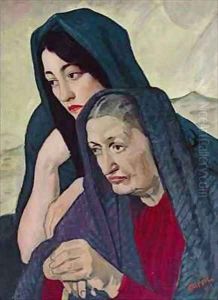John Currie Paintings
John Currie, although not a widely recognized name in the annals of art history, was a British painter whose career showcased considerable talent and promise before it was tragically cut short. Born in 1883 in the small town of Irongray, Scotland, Currie demonstrated an early aptitude for the arts and subsequently pursued his passion for painting. He moved to England, where he continued to develop his skills, enrolling at the Manchester School of Art. There, he honed his craft, embracing the techniques that would later define his work.
Currie's style was influenced by the post-impressionists, and he was known for his bold use of color and a tendency to explore the psychological depth of his subjects. His work often contained a strong narrative element, which set him apart from many of his contemporaries. In 1905, he was awarded a scholarship to the Slade School of Fine Art in London, which was a leading institution for art training at the time. At the Slade, he was exposed to the leading artistic movements of the day and interacted with fellow artists who would go on to become notable figures in the British art community.
Despite his potential, Currie's life was marked by personal turmoil. His tumultuous relationship with his model and lover, Dolly Henry, ended in tragedy when, in a fit of jealousy, Currie shot her and then turned the gun on himself. This violent act on October 24, 1914, ended Currie's life at the age of 31 and cast a dark shadow over his legacy. The incident shocked the artistic community and undoubtedly influenced the posthumous reception of his work.
Currie's paintings were marked by a dramatic intensity, and although his career was brief, his works were exhibited at several important venues, including the New English Art Club. After his death, Currie's work was largely overshadowed by his contemporaries and the sensational nature of his demise. However, art historians have since recognized the merit and intensity of his work, granting him a modest place within the tapestry of early 20th-century British art.
